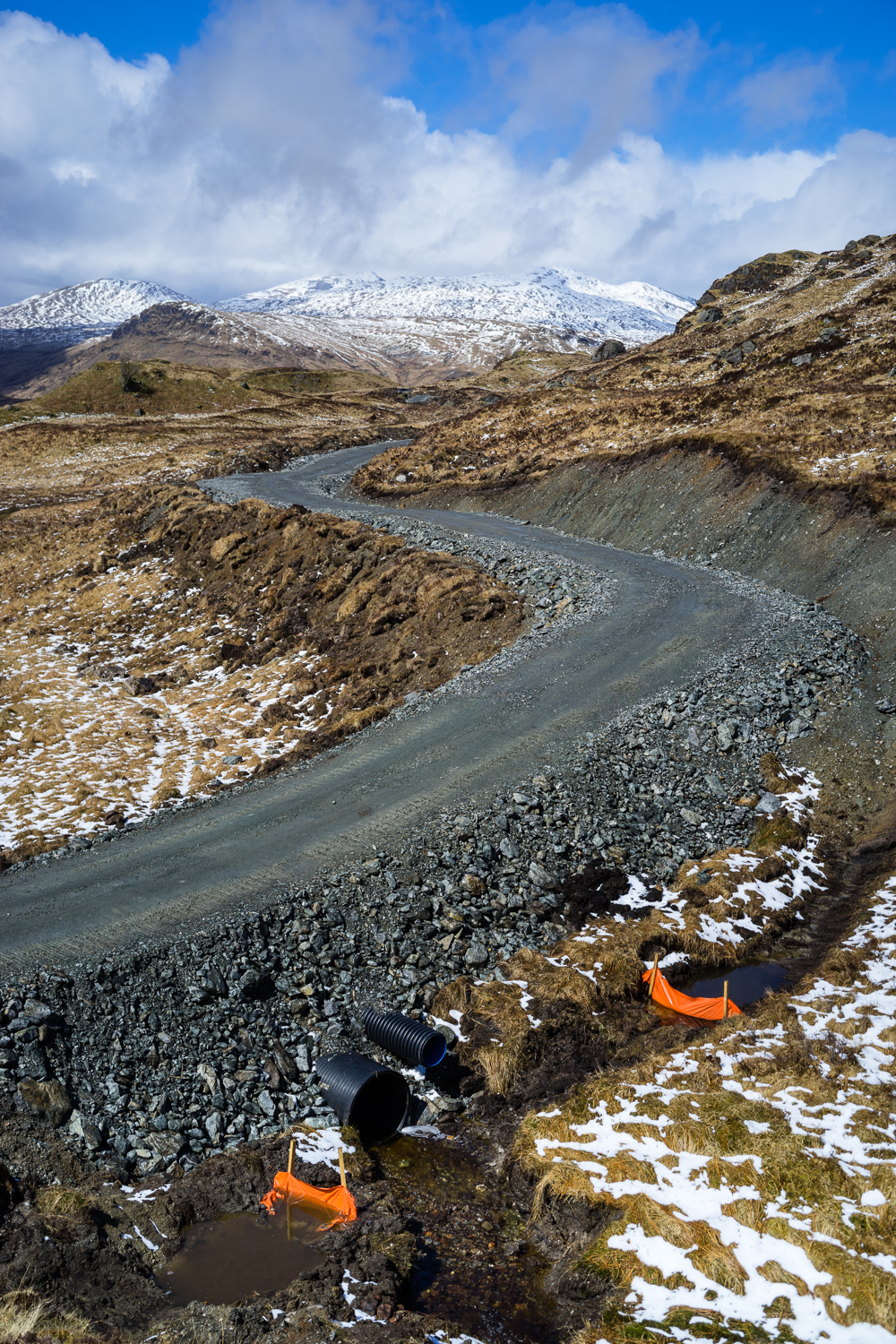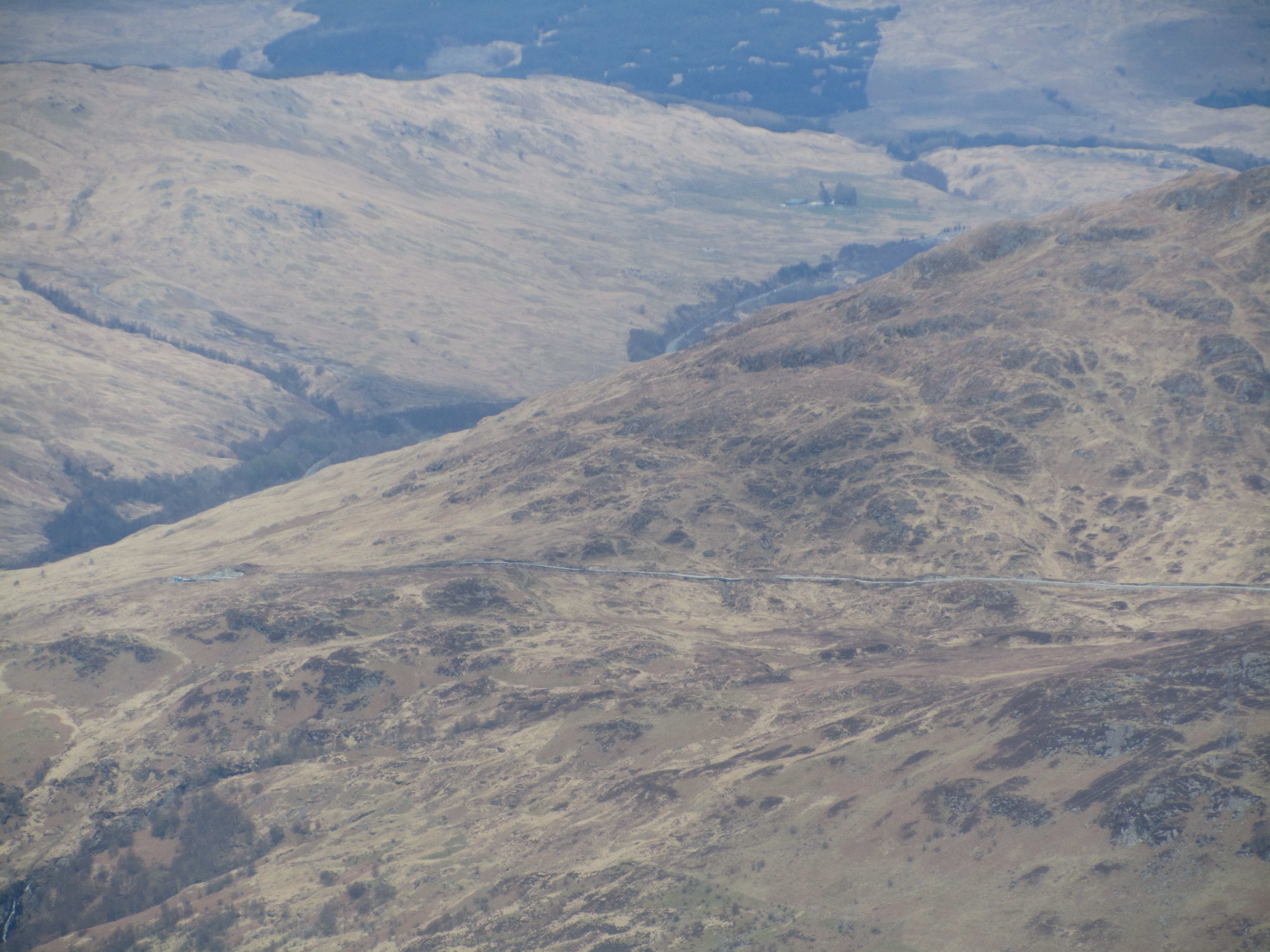David Lintern, the wild land photographer who writes for Walk Highland, contacted me last week about the Ben Glas hydro scheme, above the Beinglas farm campsite at the head of Loch Lomond. He has written a heartfelt and poetic piece on his blog http://www.davidlintern.com/blog/ about this, along with photos which show the destruction that is taking place in the Loch Lomond and Trossachs National Park and the beauty that survives. He has kindly provided me with a photo to publish here but I would recommend looking at his blog. This includes photos of the fine hummocky ridge of Ben Glas that leads, after a fair amount of up and down, to the summit of Beinn Chabhair and the Lochan of that name.

I have walked or tried to run the Ben Glas/Ben Chabhair ridge several times, sometimes starting up the path by Eagle Falls, and to my mind it is one of the best walks up a Munro in the National Park. Once above the Eagle Falls, you were suddenly in an area that felt wild, away from it all – marred only for a short way by the tracks of All Terrain Vehicles that had come up the track to the North. The Lochan a Chaisteil, nestled on the ridge, like a fortress – hence its name I guess – was one of the finest places to picnic, camp, swim or simply loiter in the whole National Park, but now overlooks the new track that has been extended up the Ben Glas Burn.
I am certain the National Park’s response to David would be that this is the last of the four Glen Falloch hydro schemes, work is still in progress and the damage will be restored and that to judge this scheme because of photos taken at a particular point of time is unfair.
I will come back to the question of how far such damage can be restored in a post in the next few days on the other Glen Falloch schemes. I had however been on Ben Vorlich recently, seen the long scar of the new track above the Eagle Falls – the light was poor but the scar stands out for miles – and had resolved to find out more. David’s contact prompted me to do so.

The Ben Glas hydro scheme is one of four in Glen Falloch which were approved back in 2010 by the Scottish Government 2009_0249_ECN-BEN_GLAS_DECISION_LETTER_AND_CONSENT-39389.
Having looked at all four schemes, I believe Ben Glas is the one that is objectionable in principle, having an impact on the landscape that can never been compensated. While its too late now, this hydro scheme should have never been allowed in a National Park:
- Not far above the Eagle Falls you used to pass over the lip of the glen, away from the noise of the traffic into another world. Hard going, even trying to follow the baggers path to Beinn Chabhair, and beautiful as David’s photos show. Untamed moor and bog, rather than grassland dominated by sheep. Prime wild land, though not marked as core wild land on the Park’s wild land map because it is not remote enough. Remoteness isn’t everything.
- The summit of Ben Glas itself, Beinn Chabhair and Parlan Hill are all however designated as wild land areas. In walking terms though, what has been constructed is a new motorway extension to Beinn Chabhair which will be permanent, however well restored. The old track from the north, which has also been extensively re-engineered, ended close to the Ben Glas burn. It now heads up the burn. According to the Park’s wild land map this was a buffer zone, intended to protect the remoteness of the core. That buffer has now been deeply punctured.
- The line of the Ben Glas burn, which supplies the hydro scheme, marks the boundary of the National Scenic Area. The burn itself and the Eagle Falls are, for a reason unknown to me, just outside it. Not that this would have made a difference in planning terms because the Park has no policy to ban renewable developments in National Scenic Areas. Their Supplementary Planning Guidance-Renewables-final guidance approved in 2013 is all about factors to consider, no absolute protection for any designated land, whether wild land, national scenic area or Site of Special Scientific Interest. Its guidance about how to do renewable development, not where to do it.
- Ironically, the land up the Ben Glas burn is not dissimilar in character to that on the north side of Ben Lomond which is fully in the National Scenic Area and where the Craig Royston hydro scheme was proposed. That proposal led to a public outcry, a 200,000 signature petition and the creation of the Friends of Loch Lomond – but not even they objected to this scheme. It seems to have passed beneath the public radar.
- The line of pylons that cross the hill to the south of the Ben Glas burn spoil the view but they are in the Loch Lomond National Scenic Area and could, one day have been removed, restoring the blemish – a suitable aspiration for a National Park. Not a reason, I believe, to justify more development, though the proximity of the national grid was what made Glen Falloch so attractive to the developers of renewables.
- Wild land aside, the most compelling reason of all why this scheme should never have been allowed is that the pipeline, running back down into Glen Falloch, will divert the water which currently flows down the Ben Glas burn away from the Eagle Falls. Yes, it will destroy the waterfall. In tourism terms, this is madness – waterfalls since Wordsworth have been one of the biggest draws to the countryside – but then the LLTNPA also approved the Cononish goldmine which basically trashes the tourist potential of that other major waterfall in the Park, the Eas Anie.
Ironically, while the Scottish Government and LLTNPA are busy promoting the A82 as a national scenic route, investing money in the sculpture at Inveruglas to encourage people to get out of their cars, they have never invested anything to encourage people to walk to the Eagle Falls, a natural attraction. Too late now, I suspect, and one less thing for walkers on the West Highland Way to enjoy.
A further irony. David Lintern pointed out to me that down the loch at Balmaha, the Park has been celebrating the life of John Muir at the National Park visitor centre. The same John Muir who fought, unsuccessfully, against the Hetchy Tetchy hydro scheme. I am pretty sure I know what he would have said about Ben Glas. I suspect the LLTNPA, if they thought about it, know too what John Muir would said but that will not stop them agreeing schemes such as Ben Glas.

The progressive industrialisation of the Loch Lomond drainage basin for hydro electric generation has degraded the scenery since the end of WWII. It was my understanding that the LL & T NP was created to protect the area from further destruction of a similar nature.
It is hard to accept that the agency established to protect the quality of the environment is complicit in further gross destruction of a wilderness area that had a place in the hearts of the people who tramped these hills for generations.
Throughout out Scotland the progressive erosion of the quality of wild land by intrusive, poorly landscaped & constructed access roads for forestry, hydro & estate management purposes is steadily destroying the quality of a visit to the Highlands. For it to be happening in a National Park is unbelievable.
The capture of the water that makes the Eagle Falls so spectacular reveals a philistine culture at the heart of the LL & T NP Authority & those who promote purportedly sustainable power generation.
How much of Scotland’s precious landscape is to be sacrificed for access roads, wind farms, power lines, hydro schemes & blanket forestry plantations?
If Scotland’s landscape is so special, why does every year bring yet more destruction of its integrity in the face of public outrage?
Evidence from past activity makes it obvious that landscape scars of this magnitude never disappear and the opportunity for the next generation to appreciate the true environmental quality of their heritage removed forever.
So well put that there’s nothing to add. Sadly 90% of the population couldn’t care less.